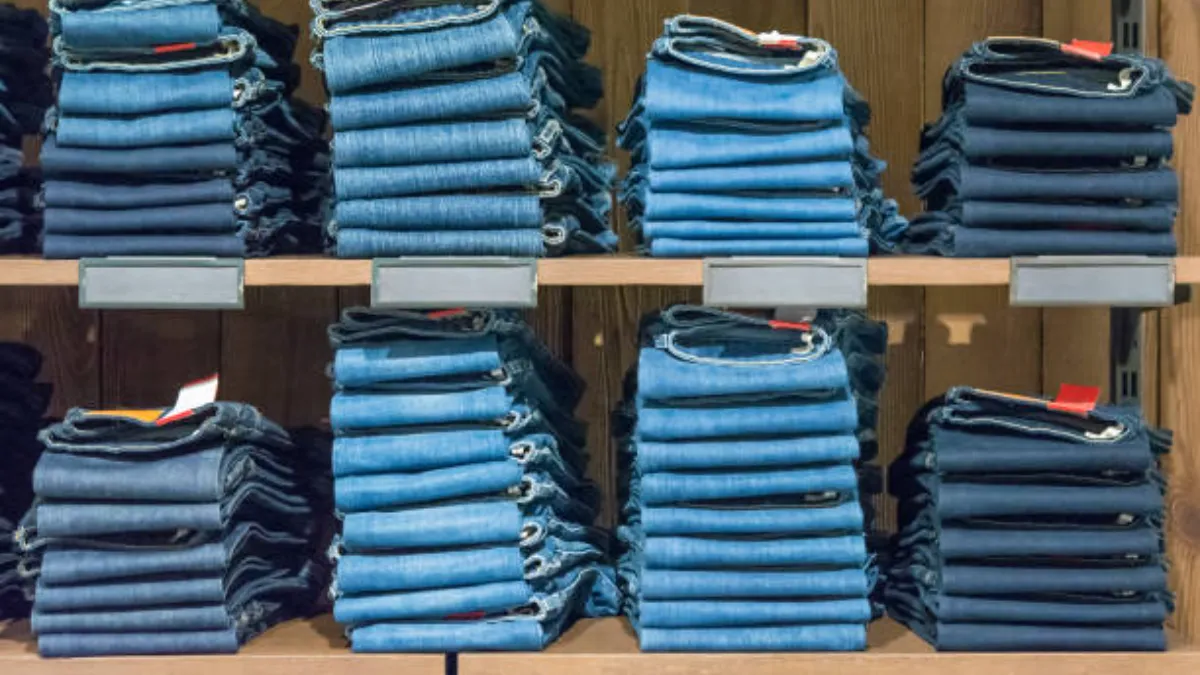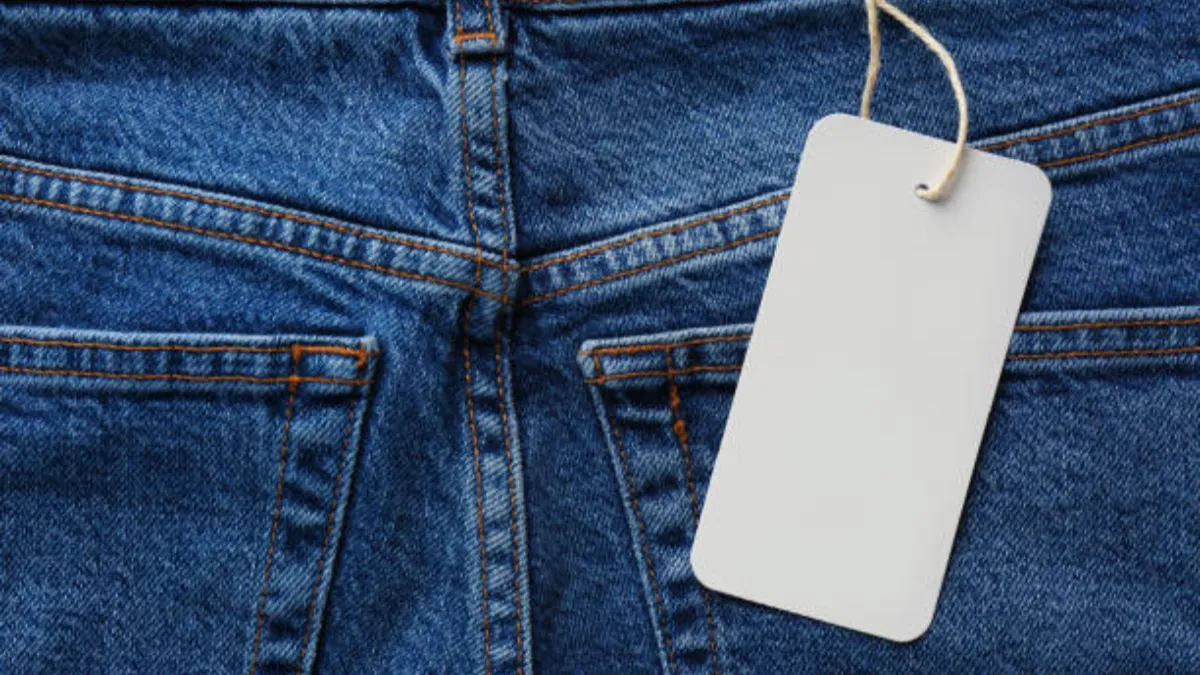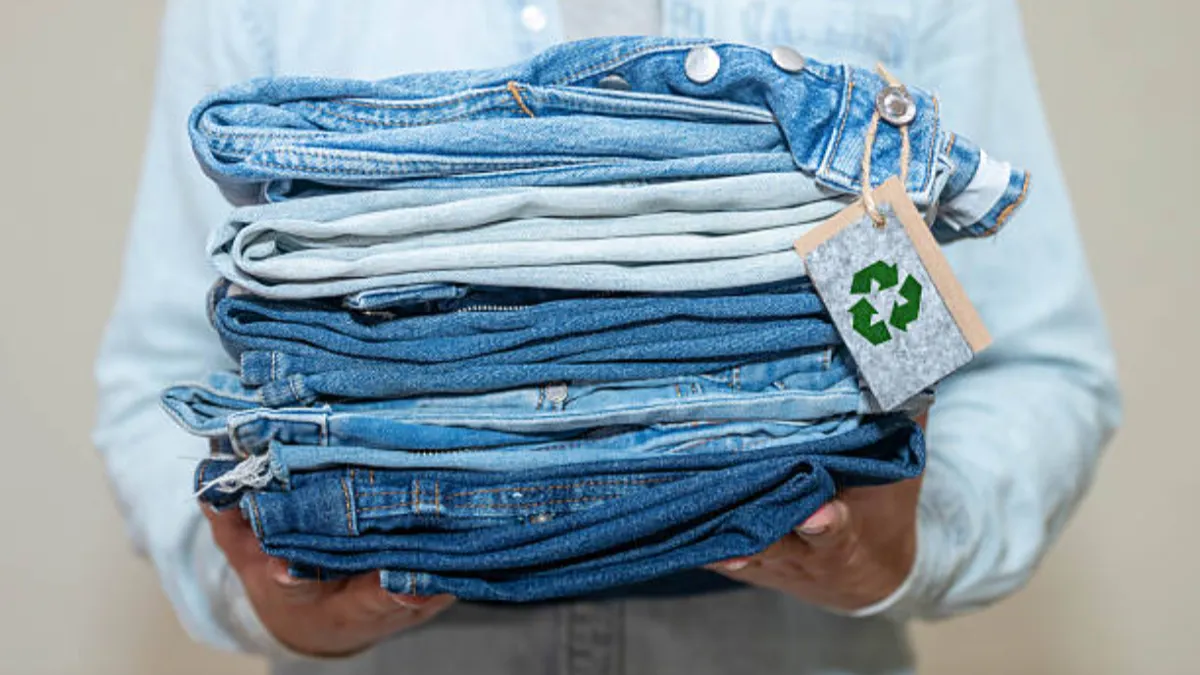Stone wash softens denim and creates a natural, broken-in fade, while acid wash produces sharper contrasts with bold, high-low tones. These two finishes differ in look, handfeel, and production impact, making each suitable for different market segments.
このガイドでは, you’ll see how both processes work, what advantages and limitations they bring, and how they influence color, wear performance, and factory efficiency. We also compare them side by side and offer practical advice to help you choose the most suitable finish for your next denim collection or large-scale production run.
What Is Stone Wash?

Stone wash is one of the most established denim finishing techniques in the industry. It uses natural or artificial pumice stones to create mechanical abrasion on the fabric surface. As the denim and stones tumble together in a rotating drum, part of the indigo layer is gently removed, resulting in a soft, 使い古された外観.
Stone wash is widely used in heritage, カジュアル, and outdoor-inspired denim because of its authenticity. It gives jeans a natural pattern that feels organic, slightly irregular, and unique to each piece. Many brands prefer stone wash when they want a lived-in look without overly sharp contrasts.
Modern manufacturers often combine stone wash with additional processes—such as 酵素ウォッシュ, ozone wash, or laser finishing—to protect fabric strength and reduce water usage. These hybrid methods balance the traditional character of stone wash with the efficiency and sustainability buyers expect today.
The Technical Process of Stone Wash
Stone wash uses pumice stones and controlled abrasion to soften denim and create a natural, lived-in look. While factories may fine-tune their own formulas, most production lines follow a similar workflow built around five key stages.
1. Garment Preparation
Before washing, each garment is checked for weak seams, 緩いトリム, and fragile metal parts. Anything that cannot withstand stone impact must be secured. Some fabrics also receive a light preshrink treatment to keep sizing consistent in bulk production.
2. Loading the Drum
Denim pieces are loaded into the industrial washer together with pumice stones. Most factories use a stone-to-fabric ratio between 0.5:1 そして 3:1, depending on how strong the fading should be. Water is added at a 3:1–5:1 liquor ratio, creating the right movement inside the drum.
3. Stone Wash Cycle
The drum tumbles at 30–60°C for 20–60 minutes. During this stage, stones rub against the fabric and slowly remove indigo from high-pressure areas. Longer cycles and larger stones produce a more vintage, high-contrast surface.
4. Rinsing and Stone Removal
Once the target shade is reached, the drum is drained and stones are removed. Rinse cycles follow to wash out dust and loose dye. This step sets the groundwork for clean, even results in the final finish.
5. 軟化 & 乾燥
A softener or a mild enzyme bath is sometimes added to refine the hand-feel. Garments are then spun, dried, shaped, and checked for shade accuracy.
Pros and Cons of Stone Wash
Pros
- Natural Vintage Look
Stone wash produces soft, organic fading that is difficult to recreate with chemicals alone. The result feels authentic and suits relaxed or heritage denim lines. - Soft Hand-Feel
Stones break down surface fibers, giving the fabric a comfortable, broken-in touch from the first wear. - Unique, Irregular Patterns
Each garment develops slightly different fading. This variation adds character, especially for premium or artisanal collections. - Compatible With Enzyme/Ozone Processes
Many factories integrate modern technologies to reduce water usage and extend fabric life while keeping the stone-washed aesthetic.
Cons
- Heavy Water Consumption
Stones must be rinsed repeatedly, and slurry disposal adds extra steps. Water use is considerably higher than modern alternatives. - Machine Wear and Higher Maintenance
Pumice fragments can damage drums, pumps, and filters, requiring more frequent maintenance. - Reduced Fabric Strength
The mechanical action removes micro-fibers, which can shorten the life of lightweight or high-stretch denim. - Lower Repeatability
Because stones create natural randomness, shade and abrasion are harder to reproduce consistently across large bulk runs.
What Is Acid Wash?
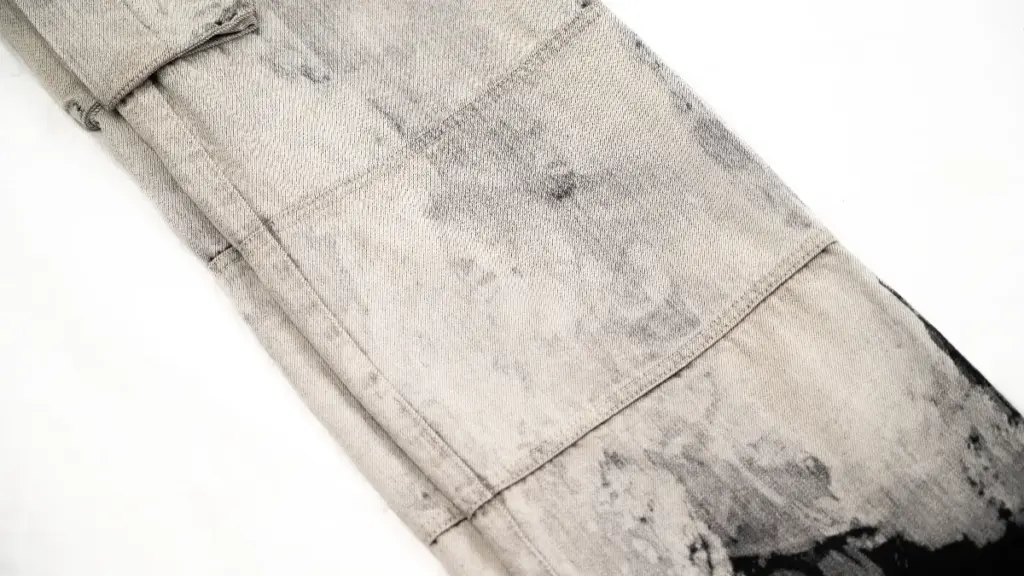
Acid wash is a technique that uses chemically treated pumice stones to create strong, デニムのハイコントラストな色落ち. Instead of relying on heavy abrasion, acid wash removes color through controlled chemical reactions. This creates sharper patterns and more consistent results compared with traditional stone wash.
Acid wash became famous during the 1980s and early 2000s, and it has returned strongly in modern Y2K fashion. Today’s chemical formulas and equipment are safer and more controlled, allowing brands to achieve clean, repeatable results without excessive fiber damage.
This method is widely used in fast-fashion and trend-driven collections because it offers accuracy, uniformity, and short processing times. Many factories now pair acid wash with ozone or laser pre-treatments to reduce chemical intensity and meet environmental standards.
The Technical Process of Acid Wash
今日, factories mainly use two approaches: the traditional stone-absorption technique and the more modern KMnO₄ spray system. Despite their differences, both follow a clear sequence of controlled steps.
1. Pre-Wash Checks
Garments are inspected to ensure they can withstand oxidation and mechanical action. Because acid wash targets dry fabric, denim must be completely dry before processing.
2. Traditional Acid Wash (Chemical-Soaked Stones)
Pumice stones are soaked in a diluted oxidizing solution, often potassium permanganate (KMnO₄). These treated stones tumble with the dry garments for a short, carefully timed cycle—usually under a minute to a few minutes. The stones transfer the oxidizer onto random areas of the fabric, bleaching indigo in irregular patterns. Once the effect is achieved, garments move immediately into a neutralization bath to stop the reaction and stabilize color.
3. Modern Acid Wash (KMnO₄ Spray Method)
Many factories now prefer spray systems for cleaner control. Technicians apply a fine KMnO₄ mist using low-pressure spray guns (commonly 2–4 bar) to create targeted contrast. Exposure is brief, and garments are neutralized right away to protect fiber strength.
4. すすぎ & Cleaning
After neutralization, garments are rinsed thoroughly to remove chemical residues. This step is essential for shade stability and ensuring the fabric remains safe against the skin.
5. Final Softening & 乾燥
Once rinsing is complete, pieces may receive a softener or enzyme wash to balance the dry hand caused by oxidation. They are then dried, shaped, and shade-checked.
Pros and Cons of Acid Wash
Pros
- 一貫性のある, High-Contrast Effects
Acid wash produces sharp, defined patterns that are easy to control and repeat across thousands of units. - Short Processing Time
The chemical reaction works quickly, allowing faster turnaround for bulk orders. - Less Mechanical Damage
Because the process relies more on chemical action than abrasion, the fabric retains better strength compared with heavy stone wash. - Easy To Standardize for Large Runs
Controlled formulas and monitored drum conditions allow stable production across multiple batches.
Cons
- Requires Strict Chemical Handling
Operators need proper PPE, ventilation, and training. Responsible waste management is critical. - Corrosion Potential
Equipment must be built from corrosion-resistant materials to avoid damage from chemicals. - Environmental Considerations
Wastewater must be neutralized and treated before discharge to comply with local and international standards. - Not Suitable for All Designs
Some premium or heritage brands may find the look too bold or artificial for their collection identity.
Difference Between Stone Wash and Acid Wash
Here is a complete table for your quick reference:
| Category | ストーンウォッシュ | 酸洗浄 |
|---|---|---|
| Overall Look | 柔らかい, natural fade with smooth transitions | Strong contrast with sharp, uneven patterns |
| テクスチャ / Handfeel | より柔らかく, more relaxed handfeel | Drier, rougher handfeel unless softened later |
| Main Mechanism | Physical abrasion from pumice stones | Chemical bleaching using oxidizers (例えば, KMnO₄) |
| Process Type | Longer, mechanical wash cycle with water | Short, controlled chemical contact on dry denim |
| Typical Temperature | 30–60°C | Room temperature (20–30°C) |
| Key Tools / Materials | Pumice stones + water + optional enzymes | Chemical-soaked stones or KMnO₄ spray |
| Production Time | Medium to long cycle (20–60 min) | Very fast (seconds to a few minutes) |
| Shade Control | Stable, gradual shade changes | High risk of over-bleaching without tight control |
| Pattern Consistency | More uniform across batches | More variation; depends on operator skill |
| Impact on Fabric Strength | Moderate abrasion; fabric weakens slightly | Chemical attack may weaken fibers more if not neutralized |
| 環境への影響 | Generates stone waste and high solid content | Requires chemical handling and proper neutralization |
| Suitable For | Classic vintage looks, everyday denim lines | Trend-driven, high-contrast, “retro” statement pieces |
| Cost Consideration | 適度 (stones + long cycle + drum wear) | Low-to-medium (chemicals cheap, process fast) |
| Best For Brands Wanting | A natural, lived-in fade with good softness | Bold aesthetics and clear high-low contrast |
| Buyer Perception | Timeless, premium, authentic | ファッションフォワード, eye-catching, youth-focused |
Stone Wash vs. 酸洗浄: Which Is Better for Your Production?
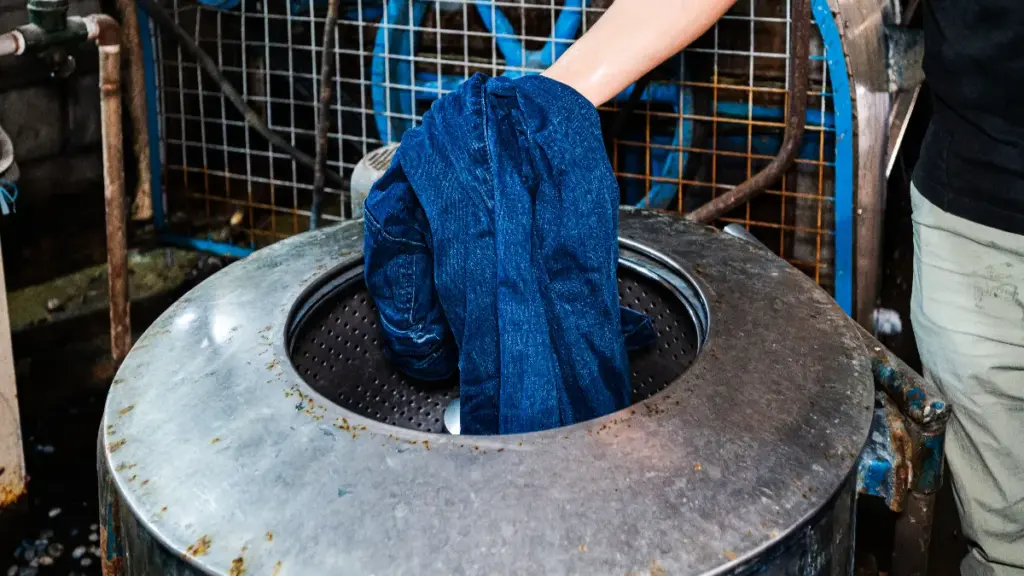
Picking between stone wash and acid wash is more than a visual decision—it shapes market alignment, production efficiency, and sustainability credentials. Having managed denim sourcing for multiple global brands, I’ve seen the right finish directly influence sell-through rates and margin stability. Below are essential factors to evaluate before selecting a process.
Assess target market preferences
Stone wash offers a rugged, vintage appeal with organic fading and pronounced texture, ideal for heritage lines or workwear-inspired collections. Acid wash delivers lighter, uniform tones with a cleaner look, often preferred in contemporary and fast-fashion ranges. Matching finish to regional tastes or retailer positioning can boost sell-in; for instance, premium European markets often lean toward enzyme-enhanced stone washes, while Asian urban segments favor controlled acid patterns for their repeatability.
Evaluate production scale and cost constraints
Stone washing’s higher abrasion cycles and greater water use slow throughput and raise utility costs. Acid wash, especially in rotary systems with precision dosing, achieves consistent results in fewer cycles—ideal for volumes above 20,000 pieces per month. Large integrated facilities can mitigate acid wash chemical expenses via bulk purchasing, whereas stone wash operations must carefully manage process variables to meet AQL 2.5 standards without delaying shipments.
Integrate sustainability commitments
Eco-focused options include ozone-enhanced stone washes cutting water use by nearly two-fifths, and low-impact acid formulas certified under GOTS or Bluesign. Partnering with mills already meeting BSCI or WRAP standards reduces onboarding risk, while manufacturers with automated water recycling systems enable smooth transitions to sustainable lines, maintaining finish consistency and meeting rising demand for low-emission, traceable production.
Premium Custom Denim Tailored for Your Brand
From fabric selection to final finishing, Guangzhou Changhong offers fully integrated manufacturing for a streamlined experience. Low order minimums make it easy to trial new designs or deliver seasonal drops, while eco-conscious wash methods like ozone and laser finishing reduce water use and chemical impact. Precision customization ensures your denim meets exact fit, shade, and hand-feel specifications.
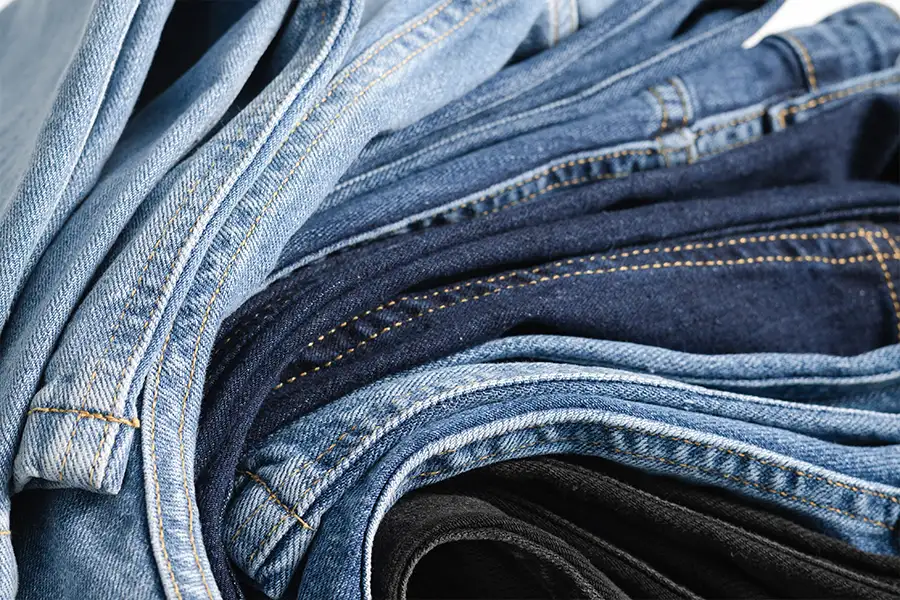
Modern Sustainable Washes Alternatives

In denim finishing, sustainability increasingly aligns with performance standards and market appeal. Many factories are replacing heavy stone and acid washes with methods that conserve water, reduce chemical use, and maintain durability. From my experience, this evolution is driven not only by compliance requirements but also by the need to build production lines that attract eco-conscious buyers without sacrificing speed or consistency.
Ozone and enzyme washing techniques
Ozone washing uses oxidizing gas to fade and bleach denim, reducing water use by roughly half and eliminating the need for pumice stones. It also cuts sludge in wastewater, lowering treatment costs. Enzyme washing, typically with cellulose enzymes, softens fabric and gently lifts indigo dye to achieve a vintage look with minimal chemical input. High-volume plants investing in ozone generators or precision enzyme dosing systems often benefit from faster cycle times and tighter shade control—an advantage when serving buyers who demand low environmental impact alongside strict AQL 2.5 quality standards.
Reducing water and chemical consumption
Closed-loop recycling systems treat and reuse rinse water, generally cutting total consumption by about a third. Advanced wastewater treatment technologies—such as membrane bioreactors or electrocoagulation—limit pollutant discharge to meet global benchmarks like ZDHC and local regulations. Facilities with integrated water management not only sustain compliance with top-tier sustainability protocols, now expected for premium denim OEM contracts, but also reduce the risk of production delays from regulatory inspections.
Balancing cost with eco-friendly goals
Green finishing lines require upfront investment in specialized washers and treatment systems but often yield long-term savings through lower utility use, reduced chemical purchasing, and stronger brand positioning. When calculating ROI, factor in reduced compliance risk, the ability to meet stricter buyer codes of conduct, and the potential for extended contracts with sustainability-focused brands. In competitive sourcing, the capability to deliver eco-friendly washes at scale can enhance negotiation leverage and justify modestly higher FOB prices.
最終的な考え
Stone wash and acid wash each offer clear advantages for denim manufacturers and fashion brands. Stone wash delivers authenticity and texture but requires more water and careful handling of fabric wear. Acid wash provides bold contrast, high efficiency, and reliable reproducibility, making it ideal for modern trend cycles.
As buyers seek both creativity and responsible production, choosing the right finishing process becomes a key strategic decision. With the right manufacturing partner—and access to modern equipment, controlled formulas, and sustainable washing technologies—brands can achieve the exact look they want while maintaining stable bulk quality.
If you need support developing custom stone-washed or acid-washed denim, Guangzhou Changhong Jeans offers flexible MOQs, 高速サンプリング, and stable production designed for long-term cooperation with growing brands.
FAQs About Denim Washing Methods
Which wash is safer for workers?
Stone wash generates airborne dust from pumice abrasion, requiring efficient extraction systems and respirator masks. Acid wash uses corrosive chemicals that demand precise dosing and robust ventilation. With either method, well-structured training programs and strict PPE enforcement are essential to safeguard production teams.
How do these washes affect longevity?
Mechanical abrasion in stone washing weakens yarns, leading to earlier seam wear and reduced tensile strength. Acid washing, driven by controlled chemical bleaching, retains fiber integrity longer. The choice depends on whether a heavily worn look is worth trading off some garment lifespan.
Are ozone or enzyme washes better options?
Ozone and enzyme techniques cut water use by roughly 40% and lower chemical discharge. When paired with modern PLC-controlled lines, they can deliver a soft hand and precise fading that meet eco-label standards. Many brands adopt them to align with sustainability goals despite higher initial equipment investment.
What are typical production costs?
Stone washing increases water, エネルギー, and machine maintenance costs but uses fewer chemicals. Acid washing raises spending on bleaching agents and wastewater treatment, yet its shorter cycles can offset some expenses. Assessing total cost of ownership gives a better comparison than reviewing individual line items alone.
How to ensure color consistency?
Acid wash achieves uniform fades through controlled bath chemistry, while stone wash produces naturally varied patterns. Consistency requires detailed process logs, calibrated timers, and pilot runs ahead of bulk production. Teams working to AQL 2.5 standards and maintaining stable parameters experience minimal shade variation between batches.


